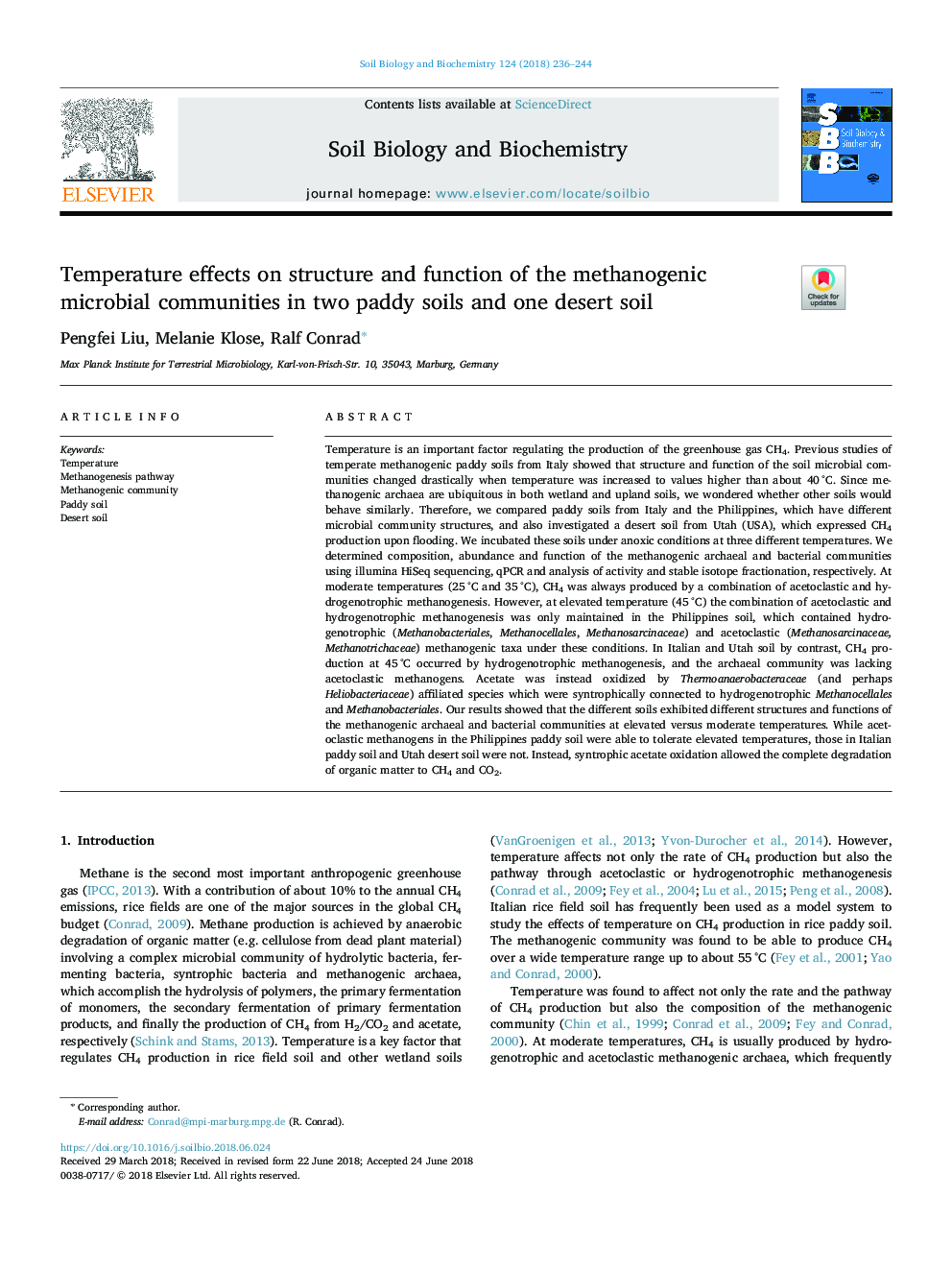| کد مقاله | کد نشریه | سال انتشار | مقاله انگلیسی | نسخه تمام متن |
|---|---|---|---|---|
| 8362607 | 1542560 | 2018 | 9 صفحه PDF | دانلود رایگان |
عنوان انگلیسی مقاله ISI
Temperature effects on structure and function of the methanogenic microbial communities in two paddy soils and one desert soil
ترجمه فارسی عنوان
اثرات دما بر ساختار و عملکرد جوامع میکروبی متانوژنیک در دو خاک خشک و یک خاک بیابانی
دانلود مقاله + سفارش ترجمه
دانلود مقاله ISI انگلیسی
رایگان برای ایرانیان
کلمات کلیدی
درجه حرارت، مسیر متانوژنز، جامعه متانولوژیک، خاک بذر، خاک کویر
موضوعات مرتبط
علوم زیستی و بیوفناوری
علوم کشاورزی و بیولوژیک
دانش خاک شناسی
چکیده انگلیسی
Temperature is an important factor regulating the production of the greenhouse gas CH4. Previous studies of temperate methanogenic paddy soils from Italy showed that structure and function of the soil microbial communities changed drastically when temperature was increased to values higher than about 40â¯Â°C. Since methanogenic archaea are ubiquitous in both wetland and upland soils, we wondered whether other soils would behave similarly. Therefore, we compared paddy soils from Italy and the Philippines, which have different microbial community structures, and also investigated a desert soil from Utah (USA), which expressed CH4 production upon flooding. We incubated these soils under anoxic conditions at three different temperatures. We determined composition, abundance and function of the methanogenic archaeal and bacterial communities using illumina HiSeq sequencing, qPCR and analysis of activity and stable isotope fractionation, respectively. At moderate temperatures (25â¯Â°C and 35â¯Â°C), CH4 was always produced by a combination of acetoclastic and hydrogenotrophic methanogenesis. However, at elevated temperature (45â¯Â°C) the combination of acetoclastic and hydrogenotrophic methanogenesis was only maintained in the Philippines soil, which contained hydrogenotrophic (Methanobacteriales, Methanocellales, Methanosarcinaceae) and acetoclastic (Methanosarcinaceae, Methanotrichaceae) methanogenic taxa under these conditions. In Italian and Utah soil by contrast, CH4 production at 45â¯Â°C occurred by hydrogenotrophic methanogenesis, and the archaeal community was lacking acetoclastic methanogens. Acetate was instead oxidized by Thermoanaerobacteraceae (and perhaps Heliobacteriaceae) affiliated species which were syntrophically connected to hydrogenotrophic Methanocellales and Methanobacteriales. Our results showed that the different soils exhibited different structures and functions of the methanogenic archaeal and bacterial communities at elevated versus moderate temperatures. While acetoclastic methanogens in the Philippines paddy soil were able to tolerate elevated temperatures, those in Italian paddy soil and Utah desert soil were not. Instead, syntrophic acetate oxidation allowed the complete degradation of organic matter to CH4 and CO2.
ناشر
Database: Elsevier - ScienceDirect (ساینس دایرکت)
Journal: Soil Biology and Biochemistry - Volume 124, September 2018, Pages 236-244
Journal: Soil Biology and Biochemistry - Volume 124, September 2018, Pages 236-244
نویسندگان
Pengfei Liu, Melanie Klose, Ralf Conrad,
